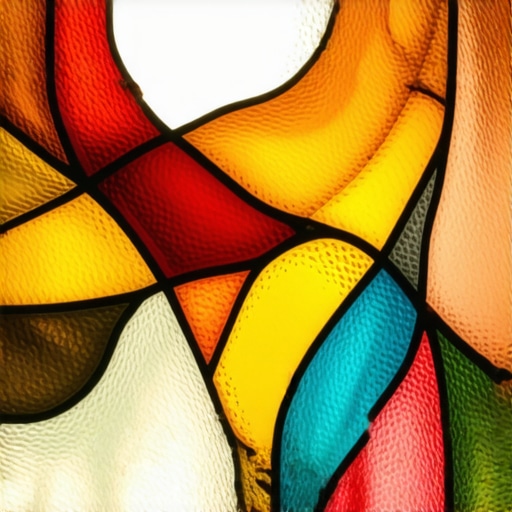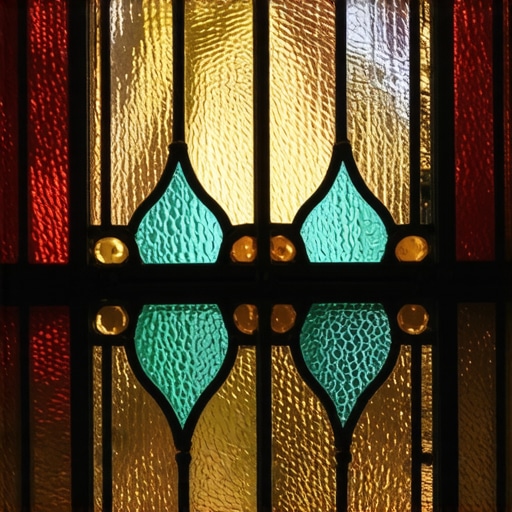Discovering My Passion for Copper Foil Stained Glass Art
My journey into the mesmerizing world of stained glass began quite unexpectedly during a DIY workshop. I was captivated by how simple pieces could come together to form stunning, colorful artworks. Over time, I delved deeper into the craft, especially focusing on the intricate technique of copper foil stained glass art. This method, pioneered by Louis Comfort Tiffany, opened up a realm of creative possibilities for me.
Why Copper Foil Technique Holds a Special Place in My Heart
The copper foil technique is renowned for allowing the creation of delicate and complex designs. Unlike lead came methods, it offers greater flexibility, enabling me to craft detailed patterns with ease. I remember working on my first intricate floral panel, feeling a surge of pride as I carefully wrapped each piece with copper foil, knowing that this technique would elevate my craftsmanship.
Unlocking Advanced Techniques for Intricate Designs
As my skills improved, I started exploring advanced methods such as foiling beveled glass, creating textured surfaces, and incorporating stained glass painting for added depth. One trick I found invaluable is using a soldering iron for fine detailing, which helps in achieving clean, precise lines. For those interested in pushing their limits, I recommend exploring resources like natural dyeing techniques to add vibrant hues to your glass panels.
How Can I Achieve Perfectly Intricate Details in My Designs?
Achieving intricate details requires patience, steady hands, and the right tools. Investing in high-quality soldering irons and magnification lamps can make a significant difference. Additionally, practicing on scrap glass helps refine your technique before tackling your main projects. Remember, each small step improves your overall craftsmanship, making your finished pieces truly stand out.
If you’re eager to elevate your stained glass skills or share your own experiences, I invite you to leave a comment below. Engaging with fellow enthusiasts can inspire new ideas and techniques!
For more comprehensive guides on DIY crafts and advanced projects, visit this helpful resource.
Unlocking the Secrets to Perfecting Copper Foil Stained Glass Art
As I continued to refine my skills in copper foil stained glass, I discovered that the devil truly is in the details. Achieving intricate designs requires more than just patience; it demands a nuanced understanding of materials, tools, and techniques. One crucial aspect is selecting the right type of copper foil tape. Thinner foils offer greater flexibility, making them ideal for delicate curves and detailed patterns, while wider tapes provide stability for larger sections. Experimenting with different widths allows artisans to find the perfect balance between flexibility and support.
The Art of Soldering: Fine-Tuning for Precision and Durability
Soldering is the backbone of copper foil stained glass, and mastering this step elevates the quality of your work. Using a high-quality soldering iron with adjustable temperature settings ensures clean, smooth solder lines. For intricate details, a fine-tipped iron provides the control needed to trace delicate contours accurately. Applying flux meticulously and using solder with a higher silver content can improve flow and adhesion, leading to a more durable and visually appealing finish. Additionally, practicing proper tinning of the copper foil edges before soldering significantly enhances the bond strength and overall appearance.
Incorporating Textures and Depth for Artistic Impact
Beyond the basic techniques, exploring surface textures can add a new dimension to your stained glass creations. Techniques such as acid etching, sandblasting, or applying glass paints can introduce subtle variations in transparency and texture, enriching the visual experience. For instance, lightly etching sections of the glass can mimic the appearance of frosted or cloudy effects, ideal for creating atmospheric scenes or soft backgrounds. Combining textured glass with smooth, vibrant sections can create captivating contrasts that draw viewers into your artwork.
What are the best methods to seamlessly integrate textured surfaces without compromising structural integrity?
This question is pivotal for advanced crafters aiming to push their artistic boundaries. The key lies in combining surface treatments with compatible glass types and carefully planning your design to distribute stresses evenly. For example, using textured glass in areas less prone to mechanical stress, and reinforcing joints with extra solder or lead came, can ensure longevity. Additionally, experimenting with layering techniques—such as stacking textured and clear glass—can achieve complex visual effects while maintaining strength. To deepen your understanding of innovative techniques, I recommend exploring expert resources like natural dyeing methods to add vibrant hues that complement textured surfaces.
If you’re passionate about elevating your stained glass craftsmanship, I encourage you to share your experiences or ask questions in the comments below. Connecting with fellow artists can inspire new ideas and technical breakthroughs!
For comprehensive guides on advanced DIY crafts, check out this resource.
Embracing the Artistic Challenge of Textured Surfaces
One of the most rewarding yet intricate aspects of copper foil stained glass art is introducing textures and depth that breathe life into our creations. I remember the first time I experimented with acid etching on a delicate landscape panel. The subtle frost-like surface transformed a flat piece into an atmospheric scene, making me realize how surface treatments could evoke emotion and atmosphere. Each technique, whether sandblasting or applying glass paints, demands patience and an eye for detail, but the results are truly captivating.
How Do I Seamlessly Integrate Textured Surfaces Without Compromising Structural Integrity?
This question has haunted many artists striving for aesthetic perfection without sacrificing durability. My approach involves strategic planning—using textured glass in areas less prone to mechanical stress, such as background sections, allows the design to flourish without risking damage. Reinforcing joints with additional solder or lead came provides extra support where needed. Layering textured with smooth glass creates visual contrast and structural balance. For example, layering frosted glass beneath vibrant, smooth-colored sections can produce both visual depth and strength.
In my journey, I also discovered that understanding the material properties of different textured glasses is crucial. Some textures, like hammered or rippled glass, can introduce micro-stresses if not handled carefully. I always test a small piece first, ensuring that my design remains safe over time. For those eager to deepen their mastery, exploring resources like natural dyeing techniques can inspire complementary color palettes that enhance textured surfaces.
Adding Artistic Impact Through Texture and Color
Beyond technical integration, textures can be paired with colors to evoke specific moods. I love combining acid-etched backgrounds with vibrant stained glass painting to create a sense of depth and movement. The textured surface catches light differently, adding a dynamic element that changes throughout the day. This interplay of light, texture, and color transforms a simple window into a storytelling piece, inviting viewers to explore every detail.
If you’re passionate about elevating your stained glass projects, I encourage you to share your experiments and challenges in the comments below. Connecting with fellow artists is invaluable for growth and inspiration.
For those interested in exploring advanced techniques, I recommend visiting this comprehensive guide to refine your craft further.

Elevating Surface Textures: Harmonizing Aesthetics and Structural Integrity
Exploring surface textures in stained glass art involves a delicate balance between artistic vision and engineering precision. Techniques such as acid etching and sandblasting introduce subtle variations, creating atmospheric effects that captivate viewers. When integrating these textured surfaces, meticulous planning is essential to prevent micro-stresses that could compromise durability. For example, textured glass like rippled or hammered varieties should be confined to areas with minimal mechanical stress, such as backgrounds or decorative panels, while structurally critical joints benefit from reinforcement through additional soldering or lead came. Layering textured glass with smooth, vibrant sections enhances visual depth, offering a dynamic interplay of light and shadow. Experimenting with different textures and understanding their material properties—like the micro-stress tendencies of hammered glass—can lead to innovative, resilient designs. For further insights into color and texture harmony, natural dyeing techniques can be employed to complement textured surfaces, adding vibrancy and richness to your compositions.
Things I Wish I Knew Earlier (or You Might Find Surprising)
The Hidden Power of Patience
When I first started working with copper foil stained glass, I underestimated how crucial patience is. Rushing through wrapping each piece with copper foil often led to uneven edges and less polished results. Over time, I learned to slow down and appreciate each step, which truly transformed my craftsmanship and the beauty of my finished pieces.
The Subtle Art of Surface Texturing
Adding textures like acid etching or sandblasting can dramatically change the mood of your artwork. Initially, I avoided experimenting with these techniques fearing they would ruin my glass. However, embracing surface textures has unlocked a new world of artistic depth, making my projects more engaging and visually rich.
The Importance of Tool Quality
I used to think that affordable tools were enough, but investing in high-quality soldering irons and magnification lamps made a noticeable difference. Precise, clean lines and easier handling have made my work more enjoyable and professional-looking. Sometimes, a small upgrade makes all the difference.
The Value of Community
Sharing my progress and challenges with fellow stained glass artists has been invaluable. Online forums and local workshops offer support and inspiration that keep me motivated. Connecting with others who share your passion can lead to unexpected breakthroughs and friendships.
Don’t Fear Mistakes
In the early days, I was terrified of making mistakes, but I realized that each error was a learning opportunity. Some of my most interesting designs emerged from experimenting outside my comfort zone. Embracing imperfections has made my art more authentic and unique.
Resources I’ve Come to Trust Over Time
- Louis Comfort Tiffany Foundation: Their historical techniques and tutorials have been a goldmine for understanding the roots of copper foil work. I highly recommend exploring their archives for inspiration and advice.
- Glass Patterns Quarterly: This magazine offers detailed patterns, tips, and techniques that have expanded my design repertoire. It’s a go-to resource for both beginners and experienced artists.
- Art Glass Magazine: Their in-depth articles on surface textures and advanced soldering techniques have helped me refine my craft and explore new artistic directions.
- Online Workshops by Expert Artisans: Platforms like Skillshare offer courses taught by seasoned stained glass artists, making complex techniques accessible and fun to learn.
Parting Thoughts from My Perspective
Reflecting on my journey with copper foil stained glass art, I realize that patience, community, and continuous learning are key. The intricate details and textures that I once thought were out of reach now feel like natural extensions of my creativity. If you’re passionate about creating stunning stained glass pieces, I encourage you to embrace the process, seek out trusted resources, and share your own experiences. Remember, every piece you craft adds a little more beauty to the world—and that’s a truly rewarding feeling. If this resonated with you, I’d love to hear your thoughts or see your work—feel free to drop a comment below or reach out through the contact page.

